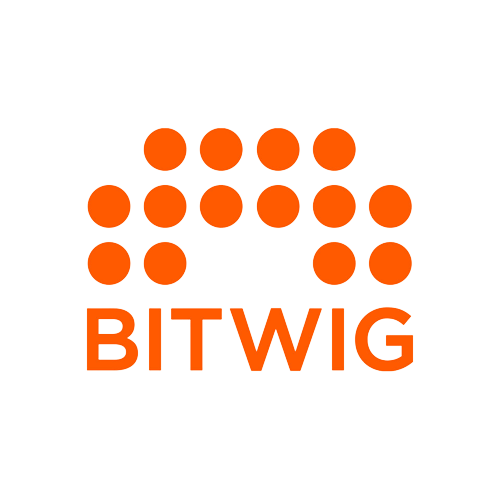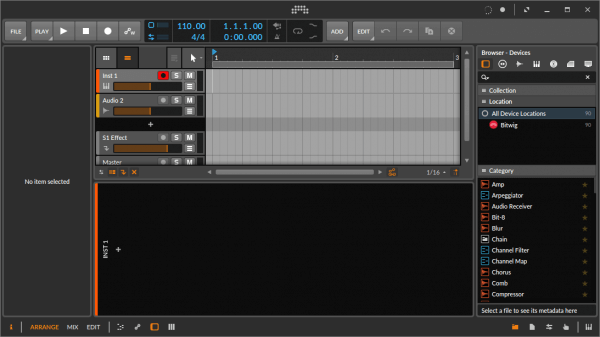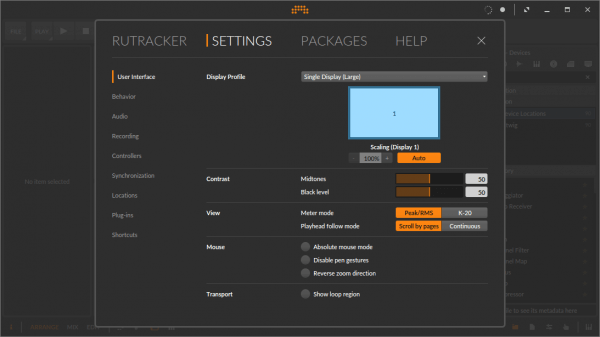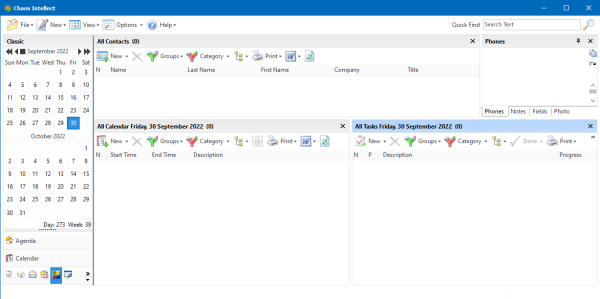
Bitwig Studio v4.4 Crack Free Download
Bitwig Studio v4.4 Crack is the one-stop solution for turning musical ideas into reality at every stage of production. Simplify your creative process and quickly develop your ideas into songs, tracks, and complete compositions. Bitwig Studio Full Version offers intuitive tools for recording, editing, and organizing any material.
Bitwig Studio v4.4 Key Features:
Audio clips are blocks of your music, and editing can be done there. Divide at the start, repeat with curves, or scale and stretch in different ways. And when the tempo changes, your audio will adapt to it, thanks to our overtime options and those of Zplane.
Our notes are dynamic, allowing for microtones, accents, panning, and more for each note. So get true polyphony from Bitwig instruments, or send those notes as MPE or CV signals. Or even add musical logic with operators, modulating when and how notes are played.
The compilation is a clean workflow for recording and then combining the best parts of multiple captures. It works on any audio clip on Bitwig, so moves freely between the arranger and the launcher. Even long audio trails to "bend" new compositions, exploring old tapes in new ways.
Polymers start simple: choose an oscillator, a filter, and an envelope generator. Replacing the Grid module in a dedicated synthesizer is quick and easy, helping you create production-worthy sounds immediately from minimal commands.
Bitwig Studio Sampler is a powerful tool for playing and manipulating audio. It offers several playback modes, an advanced looping function with crossfades, endless modulation possibilities, a great multisample editor, and much more.
Meet Phase-4, a four-oscillator synthesizer powered by phase modulation and phase distortion. This unique synth can play classic, modern, and beyond.
EQ+ is a feature-rich graphic equalizer with up to 8 bands, mouse gestures, and excellent visualization and algorithms.
A drum machine is a container device that you can fill with sonic goodness. It's never been easier to create a unique, great-sounding kit.
Individual controls for stride speed, stride length, and pitch. 17 tone models and three-octave management modes. Full MPE support. It even modulates time for shift patterns. Holding chords has never been so musical and dynamic.
The micro-pitch is a Note FX device that lets you fine-tune pitch in new ways. Change the scale, fine-tune individual notes, lower or widen the octave, or even slice the octave into different parts. Play something unimaginable today.
Inject some virtual analog grit into your sound with the Amp Kit, an incredible amplifier simulation technology.
Convolution is an effect that can transport any sound anywhere, even where it is not. All convolutions give your voice "pulses", and our sound is complete with 270 of them, from 12th-century cathedrals and legendary studio effects to more abstract "environments".
Delay+ is Bitwig's latest boutique audio effect. By balancing familiar controls with new, unobtrusive controls, Delay+ can add a bit of character or completely change your voice when playing ping pong.
Bitwig Studio's modulation system lets you use Macro, Note Expression, LFO, and Envelope controls to modulate any device, VST plug-in, or hardware parameter. With over 30 modulators (and counting), the potential for creative expression is limitless.
Let Bitwig Studio v4.4 Patch can control your hardware, or let your hardware control Bitwig Studio, or both, via MIDI, CC, CV, Gate, Analog and MIDI Clock, and MIDI Timecode. Enjoy a collection of simple tools that let you enjoy the best of both worlds and adapt to your setup.
Bitwig Studio v4.4 Serial Key handles VST and CLAP plugin hosting uniquely, allowing for different hosting modes and protection against plugin failures. With plug-ins, audio engines, and other processes running on separate threads, technical issues won't bring your entire project to a halt.
With extensive touchscreen support (multi-touch with unlimited touch points, gestures, pen support, and simulated pressure), Bitwig Studio is at the forefront of new ways to create music. Overall, Bitwig Studio's user interface is tactile; in addition, there is a dedicated tablet display profile, suitable for any touch screen or devices such as Microsoft Surface computers.
Essential Patterns is a customizable collection of Bitwig Studio Clips (basslines, chord progressions, melodies, etc.) that can include MIDI notes and messages as well as device presets...
Grand Piano Lite is a professionally sampled stereo recreation of the famous Bösendorfer grand piano, a lighter version of our larger Grand Piano set.
Essential Presets is a versatile set of the content generated by Bitwig and includes most device presets from Bitwig Studio v4.4 Keygen.
- Evolving Sounds and Sequences
The sound design comes alive with modulation.
Carefully designed wavetables in five categories: real-world acoustic instruments, various analog and digital synthesis techniques, recursive fractal spectra, and various harmonic circuits.
This pack explores the vast sonic terrain unlocked by our fun and simple Polymer synthesizer.
The Bass-08 is a digital rebirth of the legendary 808 drum machine, made possible with state-of-the-art technology from Bitwig Studio v4.4 License Key.
Electric Keys brings the original sound to life and reuses it as a modern show at Bitwig Studio v4.4 Activator.
The Notes In Motion package includes over 30 patches that generate music, rearrange the arpeggiator, note sequencer, and repeater, provide a modular drum interface, and more.
Your voice propagates using Bitwig Impulse Responses, the companion package to our Convolution suite.
Perfection is one of the greatest myths of humanity. That's why Perfect Drift Sound Pack presets embrace nature's asymmetry to approximate the beauty of imperfect analogs.
What's new in Bitwig Studio v4.4?
(Released on 05-10-2022)
New Spectral Devices, For All Bitwig Studio Customers:
- Spectral Suite, four new audio FX, and a package of sound content are now part of Bitwig Studio.
- There is a new Spectral device category, where the four new audio FX can be found.
- How do these “spectral” devices work?…
- These audio FX are frequency-domain devices, which separate the incoming sound into hundreds of pieces for analysis.
- In the frequency domain, each moment of a sound isn’t simply loud or quiet (for example); there are always frequencies that are loud and those that are quiet.
- So Bitwig does the math and then, based on the device’s orientation, related signals are grouped into “channels” for easy mixing and plug-in-friendly control.
- These devices are “containers” at heart, reconstructing the original sound… until you move one of the channel controls (Gain or Panning) or insert a plug-in.
- The sooner you adjust an audio parameter, the more obvious the devices become.
- All four devices have an identical structure for each channel:
- Gain control, in the standard volume range.
- Panning control, for stereo placement.
- An On (or “active”) switch, shown with a speaker icon beneath the Gain knob, in case you want to disable a channel.
- A Solo control, shown as an S button to the left of the Gain knob, for auditioning one channel at a time.
- A device chain, for processing this channel of audio with any Bitwig device or VST/CLAP plug-in.
- Like all nested device chains on these devices, notes reaching the device are available here, for envelope triggers, phase resets, or anything else you deem appropriate.
- All four devices also share an identical Output Section:
- A Pre FX chain is for processing incoming audio before it goes to the spectral analysis, perhaps for a Compressor or Dynamics to tighten the signal, or anything else.
- A Post FX chain, for processing the sum of the audio channels, maybe for an EQ+ to balance the full output, or your favorite plug-in, or…
- A Mix control, that blends the dry incoming signal with the final processed signal (coming from the channels and Post FX chain)
- Freq Split, Loud Split, and Harmonic Split all use similar visualizations and share a Spectrum Display Inspector parameter, with two modes:
- Pre shows the analysis data (and no audio processing from the channel controls, such as Gain or audio plug-ins), good for tweaking the splits.
- The post shows each channel’s output audio and post-processing.
New Spectral Suite Device: Freq Split (Spectral):
- Divides signal into frequency groups and sorts them into one of four channels, for individual mixing and processing.
- Frequency Splits sets the number of splits across the frequency spectrum, which works with two nearby parameters:
- Split Insertion Direction sets whether additional splits are added from the right/high edge of the spectrum (←), from the left/low edge of the spectrum (→), or around the relative middle (↔︎).
- The crossfade Amount determines the overlap between splits.
- So, with the device’s default settings, 16 Splits with an Insertion Direction putting new splits on the right (←) means:
- The 1st, 5th, 9th, and 13th split land in channel 1 (red).
- The 2nd, 6th, 10th, and 14th split the land in channel 2 (blue).
- The 3rd, 7th, 11th, and 15th split the land in channel 3 (yellow).
- The 4th, 8th, 12th, and 16th split land in channel 4 (magenta).
- And if the Crossfade Amount was increased from 0.00 % (full isolation between bands) to 50.0 %, then each split would spend its first 25 % crossfading with the previous split, and its last quarter crossfading with the next split.
- Split Nudge slides the frequency splits by an offset value, so a setting of +2.00 pushes the contents of channel 1 into channel 2, channel 4 into channel 2, and so on.
- Split Spin also slides the frequency splits but relative to the entire spectrum; so a setting of -10.0 % slides all the splits a tenth lower in the entire spectrum.
- Whether being subtle (Split Nudge) or extreme (Split Spin), modulating either of these parameters shows the “filter bank” quality of this device, creating new phasers and more when each channel is loaded with different audio FX.
- Split Bend curves the frequency split pattern around a new midpoint, either moving the midpoint downward and putting splits closer together in the lower frequencies (negative values) or moving the midpoint higher and having splits closer together in the upper frequencies (positive values).
- Split Pinch kinks the frequency split pattern, either bunching more splits around the midpoint (positive values) or putting more splits into the sides (negative values).
- In the device’s display, the interactive white dot controls Split Bend when dragged left to right, and Split Pinch when dragged up and down; it’s fun.
- The Spectral Limiter option sets a maximum Threshold level for each frequency bin.
- In the device’s display, the Threshold is shown with a horizontal orange bar that can be dragged up or down.
New Spectral Suite Device: Harmonic Split (Spectral):
- Tracks the fundamental frequency of the incoming sound, for splitting Nonharmonics (gray) to one channel and dividing harmonics between Harmonics A (orange) and Harmonics B (turquoise) channels, for individual mixing and processing.
- The harmonics Pattern decides how harmonics are distributed between the A and B channels.
- The default setting of 2 places every 2nd harmonic in the A channel, so the A channel will be odd harmonics (1st, 3rd, 5th, etc.), and the B channel receives all even harmonics (2nd, 4th, 6th, etc.).
- A setting of 4, for example, would place the 1st, 5th, 9th, etc. harmonics in channel A, and all other harmonics (2nd, 3rd, 4th; 6th, 7th…) into channel B.
- Higher values lead to narrower results in the A channel — and the potential for more extreme processing without “getting into trouble”.
- A setting of 1 is special, routing only the fundamental to channel A and all other harmonics to channel B.
- Nonharmonic Sensitivity is a relative control for how picky the harmonic vs. non-harmonic split is, where a higher Sensitivity value allows less audio into the Nonharmonic channel — and more audio into the two Harmonics channels.
- The Maximum Harmonics Inspector parameter allows you to limit the number of harmonics being tracked, acting as a “ceiling” when you want fewer frequencies in the Harmonics A and B channels.
- Fundamental tracking can be adjusted with several analysis parameters:
- Tilt favors the high frequencies (when positive) or low frequencies (when negative), useful when the desired fundamental is filtered in the sound, etc.
- The Low-cut Frequency and High-cut Frequency parameters narrow the frequency tracking area.
- An amplitude Detection Threshold can be set, keeping moments that stay below that level in the Nonharmonics channel.
- In the device’s display, the Detection Threshold and Cut Frequencies are interactive lines that can be dragged.
- The device display also illustrates the currently-detected fundamental with a white dot and moving crosshairs.
NEW SPECTRAL SUITE DEVICE: LOUD SPLIT (SPECTRAL):
- Uses two thresholds to separate the Quiet (green), Mid (yellow), and Loud (red) portions of the incoming sound, for individual mixing and processing.
- A Higher Threshold (red) sets the level where stronger signals are considered Loud.
- A Lower Threshold (green) sets the level where weaker signals are considered Quiet.
- In the device’s display, both thresholds are visualized as horizontal lines, which can be dragged up and down.
- When clicking a line’s dot handle on the right, only the outer band of that threshold will be heard while the mouse is held.
- Any signal falling between the two thresholds is considered Mid.
- Relative Loudness Mode follows the level of the incoming sound, treating 0.0 dB as the strongest band at any given moment.
- Relative Loudness Mode uses separate Relative Higher Threshold and Relative Lower Threshold parameters.
- Each threshold has its Knee value, for setting the transition (and effective crossfade) between adjacent channels.
- In the device’s display, ALT-dragging on either threshold adjusts its Knee parameter.
- Rise Time sets the number of blocks before a softer signal fully transitions up into a louder band, like a “resistance” parameter.
- Fall Time sets the number of blocks before a louder signal fully falls into a quieter band, like a “decay” parameter.
- Tilt is an analysis parameter, favoring the high frequencies (when positive) or low frequencies (when negative) before the channel splitting is applied.
New Spectral Suite Device: Transient Split (Spectral):
- Separates the Transients (short, unstable sounds; colored yellow) and Tones (periodic or pitched sounds; colored blue), for individual mixing and processing.
- Analysis Bias either skews the detection to favor Transients (positive values) or Tones (negative values).
- The Transient Type Inspector parameter switches between two different algorithms for which type of Transient is being looked for:
- Percussive searches for typical impact transients, good for drums or other things that “click” and “smack”.
- Noise looks for noisy smears or even reverb residue.
- Transients Decay sets a time (in blocks) for extending detected Transients, allowing them to release.
- Tones Smoothing sets a time (in blocks) for extending detected Tones, allowing them to decay.
- Tilt Amount is an analysis parameter that is colored yellow as it is oriented to how it affects the Transients channel; its effect is the opposite for the Tones channel.
- The Tilt Mode Inspector parameter changes the method of Tilt applied, between a Standard model that favors the Transient channel’s high frequencies (when positive) or its low frequencies (when negative), or a Contour approach that subtly adjusts the mid frequencies vs. the highs & lows.
- Transient/Tones Blend is the audio balance at the output of the spectral section before each signal reaches its channel.
- The Display Style of this device is unique, with two modes:
- The waveform shows a split amplitude domain representation of the two groups.
- The sonogram offers the recent frequency-domain history for each group.
New Features:
- There is now a Japanese translation of the Bitwig Studio v4.3.0 manual.
- Device context menus have been reorganized so that device-specific entries come near the top of the list (for example, the Spectrum Displays setting for three of the Spectral devices).
Screenshots:










